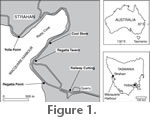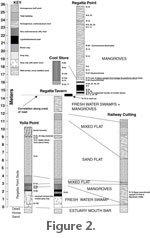| |
INTRODUCTION
The Early Eocene includes two periods of globally warm temperatures where thermophilic vegetation (among other biota) extended its range significantly towards the poles; these were the Paleocene-Eocene Thermal Maximum (sometimes known as the Late Paleocene Thermal Maximum) and the Early Eocene Climatic Optimum (Katz et al. 1999;
Zachos et al. 2001,
2005). Today the world is also undergoing profound warming due to anthropogenic greenhouse gases (Intergovernmental Panel on Climate Change 2007) and understanding the effects this will have on the biota and local climates has become a key research goal. To test the accuracy of global climate models for future terrestrial climates in a high-greenhouse state,
we must identify an analogous period in the past and analyse its plant fossils. With a few exceptions, most of the terrestrial climate data for the early Eocene come from the northern hemisphere and from mid-latitudes. This paper attempts a detailed documentation of the vegetation from a high-latitude Southern Hemisphere Early Eocene locality. It mostly uses the evidence of leaf cuticle as a taxonomic tool. While this technique has been used for more than 50 years in parts of Europe, and has become standard in Australasia (e.g.,
Hill and Carpenter 1991;
Jordan et al. 1998;
Pole 2007a, its use in the Cenozoic of North and South America is still almost non-existent. Part of the problem may be the lack of broad, critical treatments of cuticle morphology, which give a researcher a basic framework to start within. This paper contributes toward
filling this knowledge gap.
 The township of Strahan lies on the edge of Macquarie Harbour on the wet, western side of Tasmania at 42ºS (Figure 1) and a variety of plate tectonic reconstructions (e.g.,
Veevers et al. 1991;
Li and Powell 2001) place it near the Polar Circle (66º) in the Early Eocene. The natural vegetation is a mixture of cool rainforest (the mean annual temperature is about 12ºC;
Australian Bureau of Meteorology 2007) dominated by Nothofagus, and conifers of the Podocarpaceae family, wet sclerophyll forest and shrub land. The township of Strahan lies on the edge of Macquarie Harbour on the wet, western side of Tasmania at 42ºS (Figure 1) and a variety of plate tectonic reconstructions (e.g.,
Veevers et al. 1991;
Li and Powell 2001) place it near the Polar Circle (66º) in the Early Eocene. The natural vegetation is a mixture of cool rainforest (the mean annual temperature is about 12ºC;
Australian Bureau of Meteorology 2007) dominated by Nothofagus, and conifers of the Podocarpaceae family, wet sclerophyll forest and shrub land.
The fossils described in this paper come from sediments, which accumulated within the Macquarie Harbour Graben. This is a NW-SE trending basin, which probably resulted from extensional forces during separation of the Australian and East Antarctic plates (Colhoun 1989). Strahan, and the study area, lie at the seaward end of the basin.
Sediments exposed around the edges of the harbour in road cuts and in quarries are placed in the Malvacipollis diversus Zone of
Stover and Partridge (1973) with a most likely age of late Early Eocene (54.9-48.5 Ma; A.D. Partridge personal commun. in
Pole and Macphail 1996). The first paleontological work on the site was by
Cookson and Eisenack (1967), who described the pollen Monosulcites prominatus, which was later recognised as representing Nypa by
Churchill (1973). Today Nypa is the only mangrove palm, with a single, tropical species, N. fruticans. Previously described macrofossils include the conifers Araucarioides linearis and A. sinuosa (Bigwood and Hill 1985); Araucaria readiae (Hill and Bigwood 1987;
Hill 1990); Acmopyle glabra, Dacrycarpus linifolius and D. mucronatus (Hill and Carpenter 1991), a possible cycad Pterostoma (Hill and Pole 1994), and the angiosperm Eucryphia (Hill 1991). There are also overlying fossiliferous Pleistocene sediments (Hill and Macphail 1985;
Jordan 1997).
 Nypa macrofossils, including fronds, cuticle, and fruits at Regatta Point
were described by
Pole and Macphail
(1996). These are thought to be the highest latitude Nypa known, as the Early Eocene paleolatitude of Tasmania was close to the polar circle (66 ºS;
Lawver and Gahagan 2003). The study was then extended to the broader stratigraphy and sedimentology. Based on sedimentary features and the presence or absence of Nypa pollen or dinoflagellates, it was concluded that the Early Eocene environment was a tidal estuary and that basic elements of such a system, a tidal bar, mixed flats, sand flats, mangrove swamps and freshwater swamps, could be identified (Figure 2;
Pole 1998a). This was important in confirming that the fossils identified as Nypa really did occur in a mangrove environment. Nypa macrofossils, including fronds, cuticle, and fruits at Regatta Point
were described by
Pole and Macphail
(1996). These are thought to be the highest latitude Nypa known, as the Early Eocene paleolatitude of Tasmania was close to the polar circle (66 ºS;
Lawver and Gahagan 2003). The study was then extended to the broader stratigraphy and sedimentology. Based on sedimentary features and the presence or absence of Nypa pollen or dinoflagellates, it was concluded that the Early Eocene environment was a tidal estuary and that basic elements of such a system, a tidal bar, mixed flats, sand flats, mangrove swamps and freshwater swamps, could be identified (Figure 2;
Pole 1998a). This was important in confirming that the fossils identified as Nypa really did occur in a mangrove environment.
Subsequent to the sedimentological study, research has focussed on the fossil cuticle and developing a reference database of extant leaf cuticle to help identify the fossils. This study aims to build on the environmental interpretation of
Pole (1998a), by documenting the dispersed cuticle from the samples and then to see if discrete taxonomic assemblages can be recognised and related to their spatial/ecological distribution within the framework provided by
Pole (1998a). The discovery of Nypa strongly suggests that other mangrove species will also be present (Duke et al. 2002), so the search for other mangrove fossils was a further goal of this study.
|